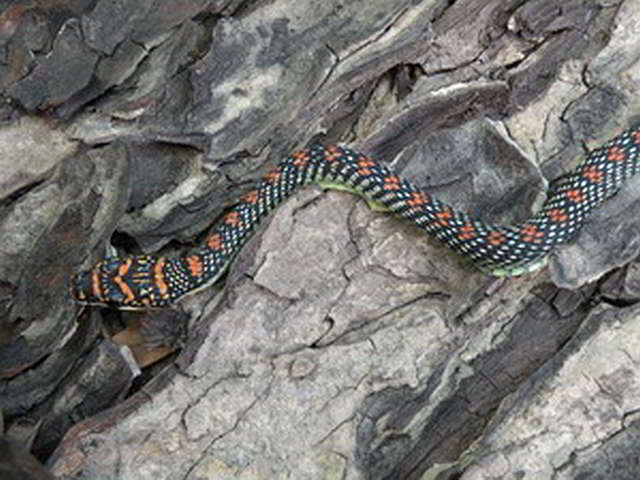 Family: Colubridae
Family: ColubridaeSubfamily: Colubrinae
Genus: Chrysopelea (Tree Snakes)

Picture: J. Bulian
 Chrysopelea ornata ornatissima (Golden Tree Snake)
Chrysopelea ornata ornatissima (Golden Tree Snake)Thai:
 (ngu kieo lai dok mak)
(ngu kieo lai dok mak)Length: Up to 140 cm
Distribution area: The Golden Tree Snake is to be found throughout Thailand.
Behaviour/habitat: Chrysopelea ornata ornattissima is a flexible snake. It can be found in forests, on plantations, in gardens and in houses. This snake is regularly found in the inner city areas of Bangkok and Pattaya. As they feed on rodents, geckos and other lizards, they are often found on and in houses. These snakes are active during the day, can climb walls and are very fast.
Danger level: If they feel threatened and cannot flee, they bite straight away. The species Chrysopelea belongs to the family of rearfanged snakes. However, the venom so mild that it does not have much of an effect on humans.

Picture: J. Bulian
 Chrysopelea paradisii (Paradise Tree Snake)
Chrysopelea paradisii (Paradise Tree Snake)Length: Malesup to 100 cm, females 130 cm
Distribution area: Phang-nga, Phuket, Ranong
Habitat/Habits: The Paradise tree snakes inhabits the forests in the lowlands and the mountains. In Thailand the distribution is restricted to the coastline. The snakes are active during the day. They mainly feed on lizards and frogs. In captivity the snakes sometimes also accept mice. The females lay twice a year a clutch of between 5 and 8 eggs. Like Chrysopelea ornata, also Chrysopelea paradisii is able to glide by spreading their ventral scales.
The specimen shown here is from the Ranong aerea. In other aereas there also can be found specimen with a basic green or even white coloration.
Danger level: Chrysopelea has grooved fangs in the back of the upper jaws. A bite has for humans normally no consequences, as the snake has to chew the venom into its victim. Only if the snake would chew several minutes on the hand of the person it could have consequences.

Picture: Stefan Fröhling
 Chrysopelea pelias (Twin-barred Tree Snake)
Chrysopelea pelias (Twin-barred Tree Snake)Length: up to 74 cm but mostly smaller
Distribution area: Nakhon Si Thammarat, Narathiwat, Satun, Songkhla, Yala
Habitat/Habits: The Twin-barred Tree Snake is the rarest species oft he genus Chrysopelea. In its habitat it is living in trees and on the ground of lowland rainforests. Chrysopelea pelias is active during the day. She feeds, as far as it is known, only on lizards and frogs. The females are laying eggs. Nothing is known about keeping and breeding this species in captivity.
Danger level: Chrysopelea pelias has grooved fangs in the back of the upper jaws. A bite has for humans normally no consequences as the snake has to chew the venom into its victim. But there is one clinical report about a bite accident from 2010 with severe symptoms of intoxication (Ahamad Khaldun Ismail et al. Clin Toxicol (Phila).2010).
Mildly-venomous/non-venomous snakes of Thailand
Venomous snakes of Thailand
≡ Menu
All data is provided without guarantee!